
Have you ever wondered what makes a Professional Learning Community (PLC) effective or ineffective? Can you confidently say that the time you spend collaborating is strategic, effective, and designed to purposely impact student achievement? Have you noticed any new challenges with facilitating PLCs in the current educational environment? Let’s examine your current practices related to PLCs and consider what you might do differently as you navigate changes in education.
What Is a PLC in Education?
While the term Professional Learning Community (PLC) has been around for over 70 years, the term and more explicit research around the subject began to develop in the late 1980s and early 1990s. Edglossary defines a Professional Learning Community as a group of educators that meets regularly, shares expertise, and works collaboratively to improve teaching skills and students’ academic performance. At its core, the shared goal of every PLC is student achievement.
We often think of PLCs in education as groups of teachers, but a PLC can also be any group of stakeholders that come together with the shared goal of improving student outcomes. This can range from the school leadership team to the support staff. That’s right. Building custodians, cafeteria workers, and security personnel can form a PLC and examine how their work impacts the culture and climate of the school and overall student performance. In fact, most effective schools ensure that all personnel understand how their role specifically contributes to the shared goal of student achievement.

Benefits and Importance of PLCs
The benefits of PLCs are not limited to students’ growth and achievement. PLCs can also contribute to creating and maintaining a thriving school culture. They can monitor the pulse of the campus and the impact of the ever-changing educational landscape that we are currently experiencing.
Reflect on March 2020, when the world shut down, and we had to educate our students in unconventional ways. For many, this required skill sets that were not fully developed. And, in some cases, the effectiveness of these skills/approaches had yet to be assessed. There were very few books and little research or strategies that could be relied on to address the challenges. Both newly formed and established PLCs collaborated on how to best meet the academic and developmental needs of students. As the world transitions to a level of normalcy, it is important that educators continue to support one another with tips, strategies, and resources as they navigate uncharted paths.
As you may have gleaned, there is no one-size-fits-all for Professional Learning Communities. The established purpose and goal of the team will determine the type, membership, and frequency of the PLC meetings. For example, a school focused on increasing student attendance may create a PLC that includes administration, department or grade level chairs, a PTA representative, and their community liaison. Initially, they may meet monthly to accurately define the root cause and create an effective plan to address the problem. They then may shift to meeting quarterly to monitor and evaluate their plan and adjust as needed.
PLCs can also be used to:
- Review data
- Plan collaboratively
- Support colleagues
- Reflect and share teaching practices
- Grow professionally
Reflect on the following questions as you think about creating or redesigning your Professional Learning Community:
- What are my goals?
- What group will I need to bring together to accomplish the established goals?
- What is the time frame needed to reach the goal?
- How often do I need to check in and follow up on this goal?
- What skills might need to be developed in me, my team, and students to pursue our goals?
What Makes Effective PLCs?
To explore what makes PLCs effective, you must also identify the challenges that tend to derail or make this sacred shared time ineffective. Some of the most common challenges and strategies/practices that have been proven to work in ensuring success with PLCs are outlined below:
Challenges |
Strategies/Practices |
No clearly defined goals beyond student performance |
• Define specific measurable goals • Communicate goals to all stakeholders • Paint a clear picture of what success is with this goal |
Meetings are infrequent |
• Determine a meeting cadence/schedule • Protect that time against other scheduling conflicts • Provide alternate dates for meeting interruptions |
PLCs become complaint sessions or time is lost on unrelated topics |
• Set meeting norms from the onset and ensure everyone agrees to these norms • Create an agenda focused on meeting specific goals • Share agenda and assign responsibilities before PLC |
One person does all the work |
• Create a responsibility list that shifts each meeting • Change the lead of the PLC each meeting • Create a collaborative environment • Identify the strength(s) of each team member and provide time for each member to build and develop the team in that area |
Administrator involvement is seen as oversight and not collaboration |
• Establish a culture of support, growth, and development • Administrators work directly with teachers as a colleague, mentor, collaborator in the development, execution, and evaluation of the plan • Administrators attend meetings as a collaborator and not a leader |
Growth vs Success |
• Clearly define success • Determine benchmarks of growth. What is 25% of success in comparison to 50% success? • Celebrate growth and success |
Developing YOUR Professional Learning Community
The Learn, Be, Do model is a method that has proven to be effective in growth and development. Most people begin in reverse. Why? Detailing the actions that participants must “Do” is the step that most people are familiar with or deem as the most important step when creating a plan. However, there are important steps that should be taken before any action is done.

The “Learn” part of the model is often an overlooked step. As you envision or build out your plan for developing or revamping your PLC(s), spend time reflecting on developing a shared awareness of the purpose and goals of the team, what success will look like, what has been done in the past, and what human or physical resources will be needed.
“Be” is a step for the exploration of aspirations. At this stage, consider the ideal behaviors, characteristics, and mindsets you will need in action. When time is spent determining attributes needed to lead the team, qualities needed by teachers to execute the plans, and attributes students need to demonstrate to meet the established goal, you will be better positioned to create a well-crafted plan that will set you on a path to reach your PLC goals.
***
HMH is proud to now be among the PLPG’s list of professional learning services. Explore our services here.
Join us for the 33rd Annual Model Schools Conference | June 2025 | Washington, DC















